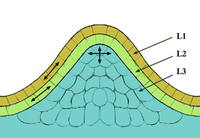
Photo from wikipedia
Bamboos (Bambusoideae) are fast-growing species due to their rapid growth rate and ability to reproduce annually via cloned buds produced on the rhizome. WUSCHEL-related homeobox (WOX) genes have been reported… Click to show full abstract
Bamboos (Bambusoideae) are fast-growing species due to their rapid growth rate and ability to reproduce annually via cloned buds produced on the rhizome. WUSCHEL-related homeobox (WOX) genes have been reported to regulate shoot apical meristem organization, lateral organ formation, cambium and vascular proliferation, and so on, but have rarely been studied in bamboos. In this study, the WOXs of both herbaceous bamboo species (12 OlaWOXs and nine RguWOXs) and woody bamboo species (18 GanWOXs, 27 PheWOXs, and 26 BamWOXs) were identified and categorized into three clades based on their phylogenetic relationship—ancient, intermediate, or WUS clade. Polyploidy is the major driver of the expansion of the bamboo WOX family. Eight conserved domains, besides the homeodomain, were identified by comparatively analyzing the WOXs of dicot and monocot species. Intensive purifying selection pressure in the coding region of specific domains explained the functional similarity of WOXs between different species. For Bambusoideae WOXs, polyploidy is the major driver of the expansion of the WOX family. Stronger purifying selection was found in orthologous WOXs of Bambusoideae, especially for WOX4s and WOX5s, which are conserved not only at the translational levels, but also at the genome level. Several conserved cis-acting elements were discovered at similar position in the promoters of the orthologous WOXs. For example, AP2/ERF protein-binding elements and B3 protein-binding elements were found in the promoters of the bamboo WOX4, while MYB protein-binding elements and Dof protein-binding elements were found in the promoters of bamboo WOX5, and MADS protein-binding sites was found in the promoters of bamboo WUS, WOX3, and WOX9. These conserved positions may play an important role in regulating the expression of bamboo WOXs. Our work provides insight into the origin and evolution of bamboo WOXs, and will facilitate functional investigations of the clonal propagation of bamboos.
Journal Title: Biomolecules
Year Published: 2020
Link to full text (if available)
Share on Social Media: Sign Up to like & get
recommendations!